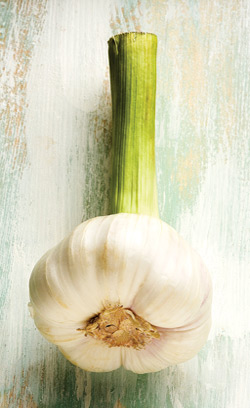That Other Bulb: The Stinking Rose
Ruth Furman writer
 With the imminent arrival of fall there is a slow down in the garden as we pick the last fruits of the harvest, trim back perennials, rake leaves, and tuck everything in before putting the garden to bed. Of course the spring flowering bulbs must be planted, and hopefully last spring you marked the spots where they are to go. But before you put away your spade and trowel there’s another bulb best planted now, the one Shakespeare called “the stinking rose,” which is also known as garlic. If you haven’t considered growing it yourself, consider this: 75 percent of the garlic sold in the US comes from China and has been chemically treated to deter it from sprouting during its long journey. It really is easy to grow and if you haven’t a dedicated vegetable patch, think about planting garlic near your roses or other insect-attracting perennials where it will act as an insect deterrent.
With the imminent arrival of fall there is a slow down in the garden as we pick the last fruits of the harvest, trim back perennials, rake leaves, and tuck everything in before putting the garden to bed. Of course the spring flowering bulbs must be planted, and hopefully last spring you marked the spots where they are to go. But before you put away your spade and trowel there’s another bulb best planted now, the one Shakespeare called “the stinking rose,” which is also known as garlic. If you haven’t considered growing it yourself, consider this: 75 percent of the garlic sold in the US comes from China and has been chemically treated to deter it from sprouting during its long journey. It really is easy to grow and if you haven’t a dedicated vegetable patch, think about planting garlic near your roses or other insect-attracting perennials where it will act as an insect deterrent.
A relative of onions, shallots, and leeks, garlic is a bulb made up of individual segments known as cloves. The hard or stiff neck variety, Allium sativum, has a mild flavor and is the most common and the hardiest of the three main types. The thick central stem gives it its name and it also is easy to peel. The soft neck type, Allium sativum subsp. ophoscorodon, has larger bulbs, a stronger flavor, and is used to make those lovely hanging braided bunches since it stores well. Elephant garlic, Allium ampeloprasum,actually is botanically a type of leek with a mild flavor somewhere between onion and garlic; and as its name implies, the bulb is large with few cloves.
Garlic needs a cold, dormant period to produce full heads, so fall is the ideal planting time. Wait until after the first hard frost when the soil just hardens up and then plant any time until November. A sunny, open position in a moderately light soil with lots of organic matter is preferred and, if your soil is very acidic, sweeten it with a bit of lime. Keep the bulbs whole until a few days before planting but be careful not to nick them or peel off the thin papery skins. Separate the individual cloves and plant them about two inches deep and four to five inches apart with the flat end at the bottom and the pointy end up. The elephant types should be planted at least three inches deep with a minimum of six inches apart. Once the ground freezes, a layer of mulch will reduce frost heaving and wind erosion and will encourage worm activity, always a benefit. You can leave the mulch on in the spring to keep the soil moist and weed free. Don’t worry if your garlic starts to send up green shoots shortly after planting as it can tolerate freezing. Just sit back and let it grow; it’s that simple.
It’s not advisable to plant garlic from the supermarket as the origin is unknown and it may not be a variety hardy in our zone. The local farmers markets are a good source and there are many specialty gourmet garlic growers listed on the internet. A few reliable seed houses include Johnny’s Selected Seeds, Fedco, and Seeds of Change, all of which offer traditional and heirloom varieties.
Lots of myth and lore surrounds garlic and, as we approach the season of tricks or treats, the damaged cloves that didn’t get planted may come in handy. Put them in your pocket to ward off the ghoulies, ghosties, and vampires who come calling at your door after dark! ![]()
Ruth Furman is a Massachusetts Certified Horticulturist (MCH). She trained in horticulture in England and spent many happy years working and gardening there. To reach Ms. Furman, email her at: Ruth@wellesleywestonmagazine.com.
© 2011 Elm Bank Media | Beth Furman, Publisher | Beth@ElmBankMedia.com


recent comments